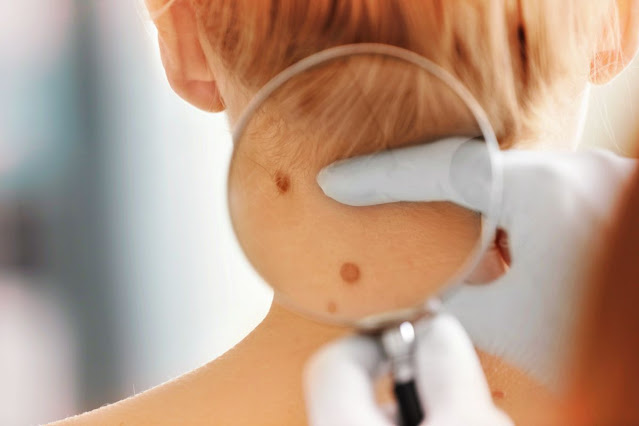SKIN CANCER SYMPTOMS
Skin cancer, including melanoma, is well treated in the early stages. The most important thing is to recognize the signs of pathology in time and start treatment. The USA Best Doctors provide the best treatment in medical field. In addition, it is essential to correctly identify a new skin growth that could potentially be malignant.
WHAT
SHOULD SKIN FORMATIONS BE SUSPICIOUS OF?
If you have a lot of moles and freckles, you
need to be very careful about any changes in pigmentation. When the mole begins
to bleed or ooze fluid, you need to go to a dermatologist. In addition, it is
necessary to watch for new formations on the skin. Many skin cancers are
essentially colourless. They are often pink or pearly papules or peeling. These
are signs of a primary tumor, and it is advisable to see a doctor. Bleeding and
wet skin formations are of particular concern.
WHO IS MOST AT RISK FOR SKIN CANCER?
People with fair skin, easily
sunburned, are more likely to develop skin cancer. This is because the skin
generates its protection against ultraviolet radiation using keratin and
melanocytes - cells that produce melanin. As a result, they create a tan,
protecting the skin from damage. However, when you get sunburned and
melanocytes cannot respond quickly, you are at serious risk of developing skin
cancer. And the greatest danger haunts the owners of blonde and red hair, as
they burn faster.
HOW TO
DETECT SKIN CANCER IN THE BODY?
The best way to detect skin cancer is to
examine yourself. When checking, you should consider spots on the skin. And you
have to check everything from the head (parting the hair to check the entire
scalp) to the gaps between the toes and soles. In addition, he can examine
hard-to-reach areas of the scalp and back. Having acquired the habit of
checking your skin, you will be able to notice changes. A monthly check can be
helpful. If you have had skin cancer, your dermatologist will tell you how
often you should check your skin. People of all ages have skin cancer. A skin
test can help you detect skin cancer at an early stage when it is well treated.
WHAT DOES SKIN CANCER LOOK LIKE?
Skin cancer manifests itself in different ways
in the body. This may look like: Change a mole or mole that does not look like
your others Dome-shaped growth scaly spot an incurable wound or a wound that
heals and returns Brown or black stripe under the nail It can also manifest in
other ways. You do not need to memorize a long list to detect skin cancer in
your body. Instead, consult a dermatologist if you notice a spot on your skin
that: Differs from others. Has it changed? Roll Bleed.
HOW DO
BASAL CELL AND SQUAMOUS CELL SKIN CANCERS MANIFEST THEMSELVES?
Most people have basal cell or squamous cell carcinoma. The most important thing to know about these skin cancers is that they are very superficial. They do not penetrate too deep into the layers of the skin. Therefore, if one species' cancer is detected early enough, the doctor prescribes a simple resection. A dermatologist or therapist may perform a biopsy to determine the nature of the tumor. External characteristics often determine squamous cell and basal cell carcinomas. The best doctors in USA provide more facilities in medical field. It can take the form: pronounced stained plaque, accumulation of brown nodules, ulcers raised above the skin. Such tumors are frozen, burned, or excised. All these methods are equally effective.
HOW
MELANOMA MANIFESTS ITSELF
Melanoma differs from basal cell and squamous
cell skin cancers primarily in that, unlike the previously described cancers,
it does not penetrate the deep layers of tissue; this tumor has the potential
to grow and spread. The deeper it penetrates the skin, the higher the risk of
its further spread throughout the body. Metastatic melanoma is a hazardous
disease. However, melanoma can be cured entirely if detected early until it has
grown deeper into the skin and metastasizes to internal organs.
Melanoma does not just penetrate
deeper into the skin - some of its cells spread around the primary tumor.
Therefore, when resecting melanoma, the surgeon must remove a fragment of
normal tissue. For example, suppose the cancer is comparable in size to a
pencil slice. In that case, you need to remove about an inch of healthy skin
around the circumference of melanoma - and possibly more if cancer has
penetrated deep into the tissue.
When melanoma grows deep into the skin, there
is a risk of it spreading to other organs. Usually, in cases of metastasis,
secondary lesions are formed in the lymphatic system, namely in the lymph
nodes. Lymph nodes under the armpits, groin, or neck begin to grow and can
reach considerable sizes. From there, cancer cells can spread to internal
organs. Therefore, in cases of deep germination of melanoma, the doctor removes
the tumor itself and checks the lymph nodes. They should have no signs of
cancer.




Comments
Post a Comment